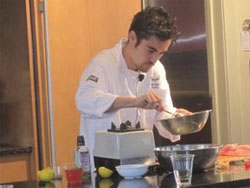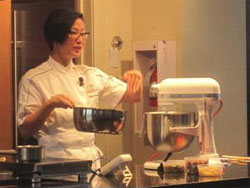Reports and Statistics
Japan’s Diversity of Green Teas Impresses Chicago’s Food Professionals
Oct 20, 2011
One of the icons of Japan is a cup of steaming green tea. It is believed to have been brought to Japan from China in the 8th century and is a mainstay of every Japanese home and restaurant. Today, green tea is reaching a global audience and is served hot, cold, blended into frothy drinks with milk, and increasingly used as an ingredient in both sweets and savories. We can clearly see the number of green tea products, both hot and cold, has increased significantly on chain menus in recent years.
On October 20th, Chicago’s food and beverage industry came together to discover the green teas Japan is famous for at the “Japanese Green Tea Showcase.” The Consulate General of Japan at Chicago and the Japan External Trade Organization (JETRO) Chicago office co-sponsored the event at the prestigious Kendall College. In addition to meeting ten specialized importers and distributors of tea under one roof, attendees heard an expert on green tea, and chefs demonstrated and offered samples of unique dishes they had created using green tea as an ingredient. Exhibitors offered a wide variety of their Japanese green teas for attendees to taste and compare, ranging from densely concentrated matcha powders and traditional types such as sencha, bancha and genmaicha to surprising blends with citrus and florals, served both hot and iced. The event gathered over 100 attendees representing restaurateurs, chefs, food and beverage retailers, wholesalers, caterers, culinary instructors, culinary and hospitality students and media.

The event attracted many attendees

Chef Shin Thompson of Bonsoiree
The newly appointed Consul General of Japan at Chicago, Yoshifumi Okamura, former Japanese ambassador to Ivory Coast, opened the first showcase on tea by reminding the audience that Japanese drink green tea every day and encouraging U.S. consumers to drink more green tea. He was followed by Sylvana Levesque, Vice President of Business Development at Keiko Tea, a specialist on the history, growing regions, harvesting and processing methods, and features of the many green tea varieties of Japan. She explained most of the twenty types of Japanese tea are not oxidized like black tea but are fixed by steaming soon after picking. Additional roasting or panning is used to create some of the aromatic green teas found in Japan.
Levesque encouraged restaurateurs to offer their customers a range of green teas in a “tea menu” or “tea list” to broaden their appreciation of the quality and wide diversity available. Tea pairings are a good way for customers to try the flavor profiles of various teas with food and tea sommeliers’ recognition is growing. The notion of “terroir” – the unique combination of a region’s soil, climate, growing methods and know-how associated with wine - can be applied to the cultivation of tea in Japan, she said. Levesque gave advice on how to prepare green tea and stressed that appropriate temperature hot water is key to bringing out the flavor components and avoiding astringency.
Asked to use green tea as an ingredient, Chef Shin Thompson, Executive Chef and Owner of Michelin-starred Bonsoiree restaurant, gave a dynamic demonstration of his recipe using genmaicha (a popular type of green tea mixed with roasted rice) to dress a sashimi dish, “Genmaicha Hiramasa Tartare.” He used a sweetened genmaicha iced tea infused with plums to make a vinaigrette for the fish with honey, Dijon mustard, lemon and grapeseed oil and topped it with Japanese chili pepper (togarashi), fish roe (tobikko), diced red pepper and fresh plums. Attendees were given samples of Chef Thompson’s delicious dish along with his carbonated plum-genmaicha iced tea.
Green tea flavored desserts are popular in Japan but are just gaining recognition in the U.S. so Chef Della Gossett, Chef Instructor at The French Pastry School of Kennedy-King College and former pastry chef at Charlie Trotter’s, used her award-winning expertise with sweets to create an innovative twist on nougat candy for the audience. Her inspiring demonstration used sencha powder to impart a light green tea flavor to a honey, cocoa, candied ginger and nut-filled nougat. In addition to bringing samples of this dish, Chef Gossett also treated the attendees to a green tea powder covered chocolate candy she created for the event.
Attendees were also able to try these and other sweets exhibitors provided either made with green tea or that pair well with it during the networking portion of the event. A Kendall College chef instructor remarked that in bringing her class to expand their knowledge of green tea, she herself had learned a lot. The wide assortment available, the depth of their flavors and potential as ingredients instilled a new appreciation of green tea in the attendees. Exhibitors commented that this event’s value lies in creating a deeper understanding of the product by Chicago’s food professionals. Although Chicago’s market for Japanese food products is smaller than on the coasts, the government of Japan wants to try to encourage growth through holding such events.

Chef Della Gossett of French Pastry School



